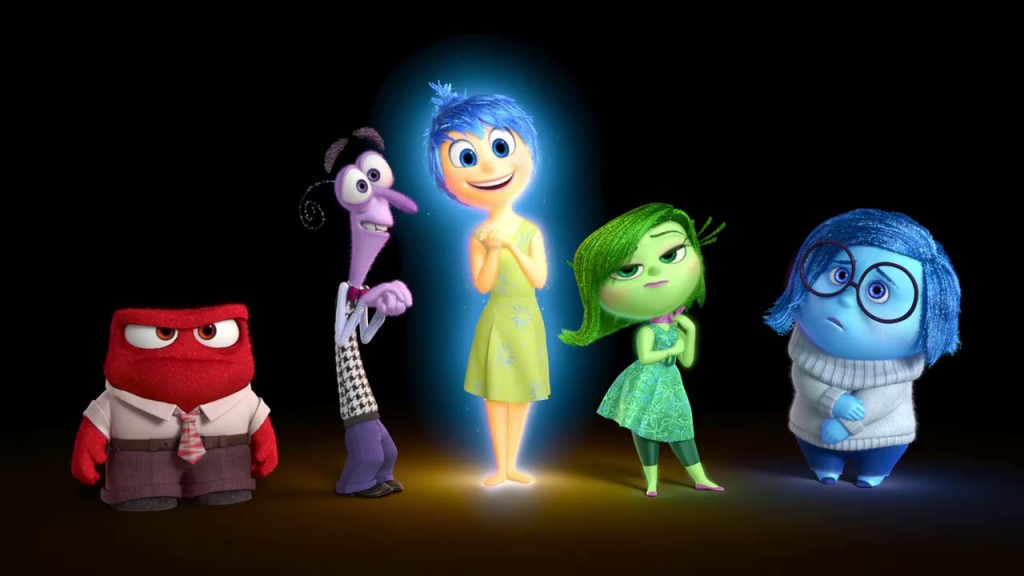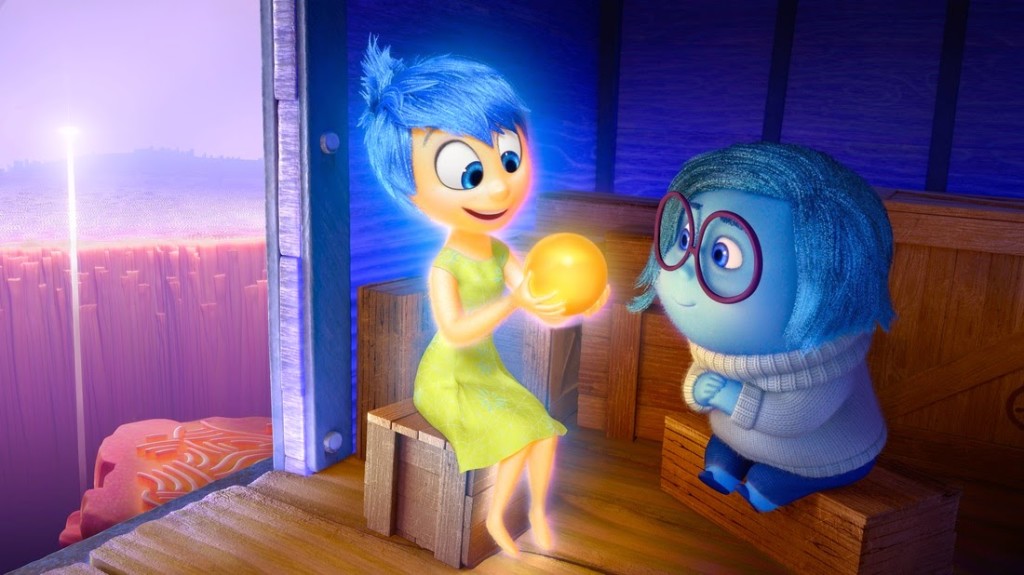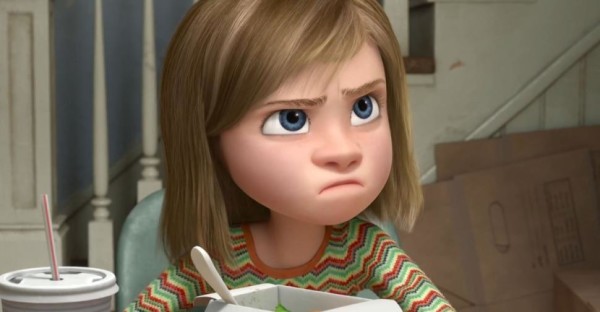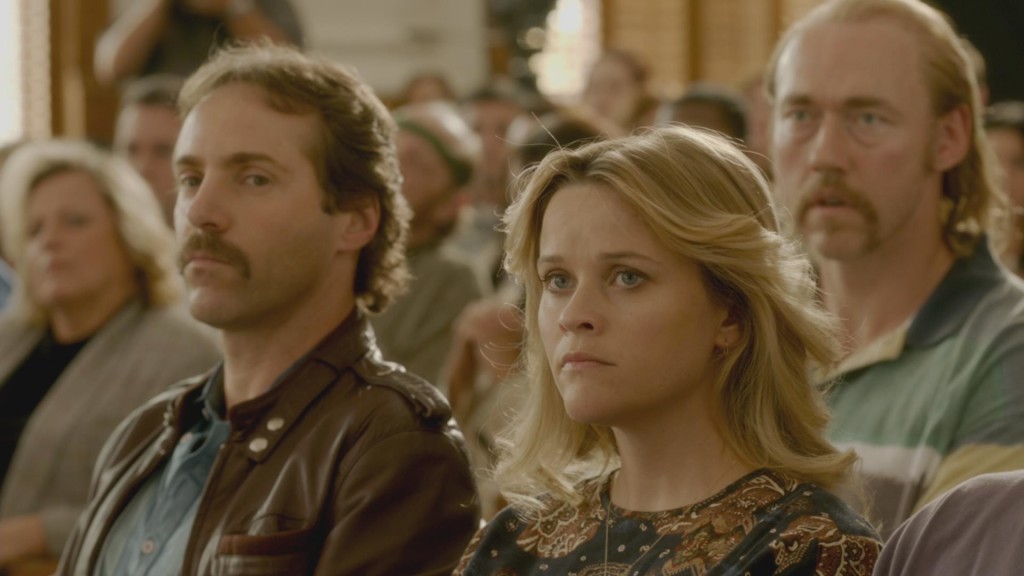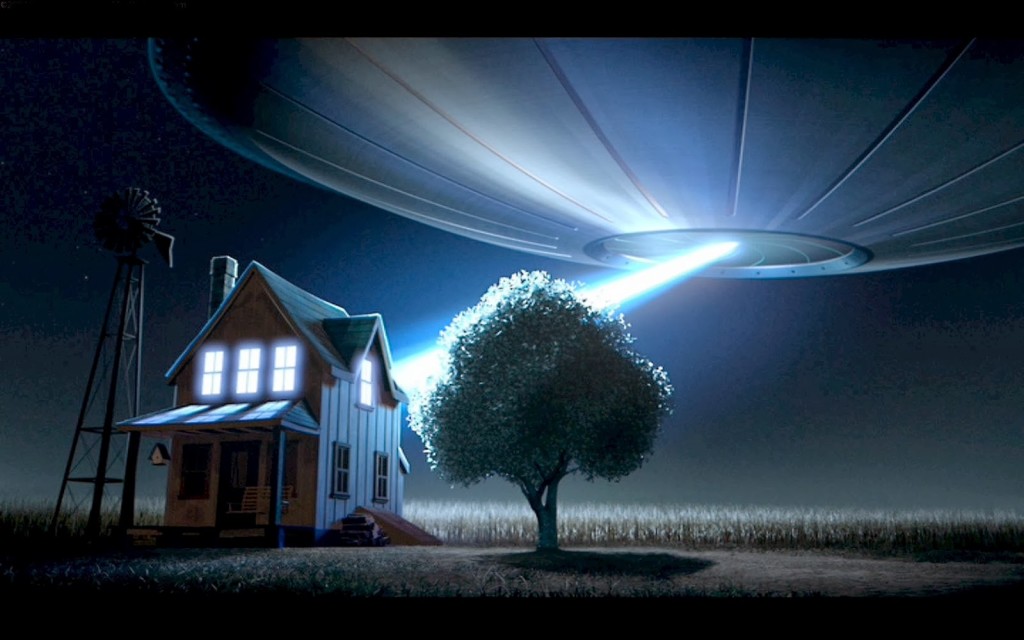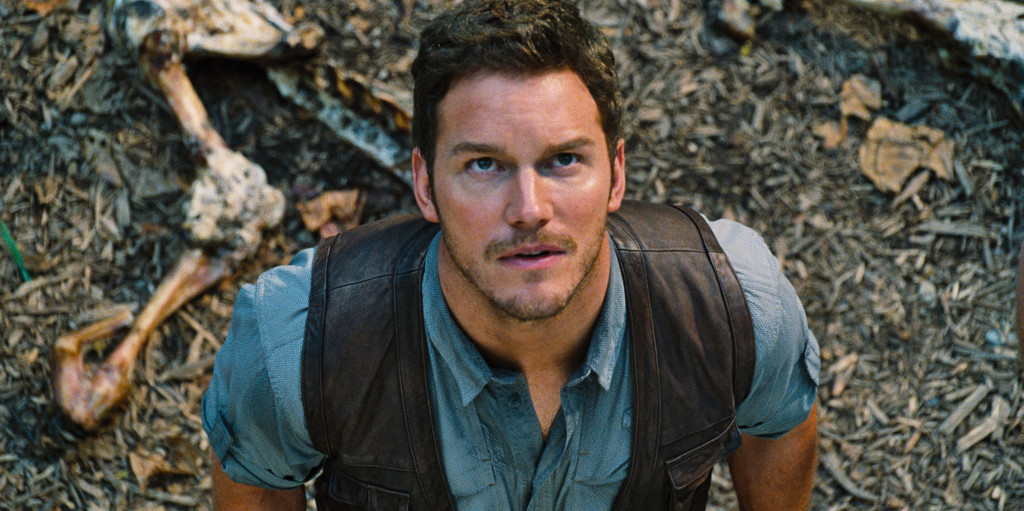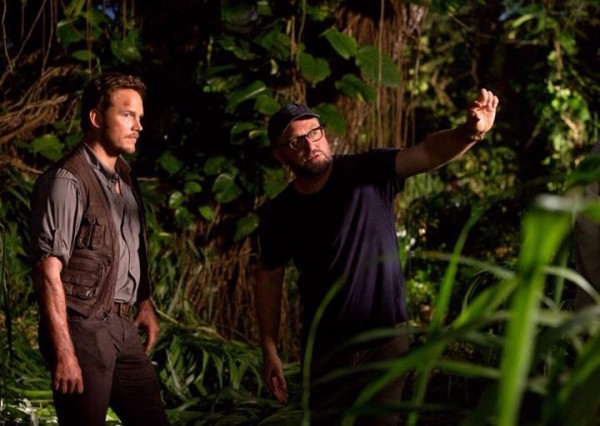Pixar continues to make a laughingstock out of the competition with its storytelling skillz.
Genre: Animation Drama/Comedy
Premise: We follow the physical embodiment of an 11 year-old girl’s emotions as her family makes the move from Minnesota to San Francisco.
About: Inside Out may not have taken down Chris Pratt and his dino-pals this weekend, but the animated feature did score a 91 million dollar take, making it the highest grossing original idea… EVER.
Writers: Meg LeFauve & Josh Cooley and Pete Docter (story by Pete Docter and Ronaldo Del Carmen)
Details: 94 minutes
One of the reasons Pixar is so successful is that they take chances. Unlike Disney or Dreamworks or Fox Animation, their first thought when coming up with an idea isn’t, “How many toys will it sell?” It’s “How can we write a great story that’s going to move people?” We’re talking about the company that brought the world an 80 year-old protagonist whose wife just died here.
Pixar also puts a ton of stock into feedback. They don’t follow the traditional model of “auteur Russian roulette” which offers a big ego-centric director carte blanche over their movie and whatever he comes up with, he comes up with.
Each draft of a Pixar screenplay is heavily scrutinized by the Pixar brain trust. If something’s not working, they’re going to tell you. And it’s one of the reasons the company has such a good track record. Their screenplays have been put through the ringer.
Inside Out is easily the most ambitious idea Pixar has ever had. Instead of featuring the go-to character groups of humans or animals, Pixar’s replaced them with things that don’t even exist. The movie doesn’t even take place in a realistic environment. It takes place inside someone’s mind, requiring the writers to create an entire new world with a new set of rules.
You’ve never seen anything like it and, outside of its impending sequels, will never see anything like it again. Nobody else would’ve had the balls to make this movie, and that alone is reason to take a closer look.
Inside Out is about an 11 year-old girl, Riley. Well, sorta. That’s another thing about Inside Out. Its main character isn’t really its main character. Its true main character is Joy, the feeling at the center of Riley’s brain. Joy isn’t the only feeling in this control center. There’s Sadness, Fear, Anger, and Disgust. This 5-thing group are in charge of making Riley go.
That group meets its most difficult challenge yet when the family unexpectedly moves from the quaint confines of rural Minnesota to the urban closet of San Francisco. Riley loses all her friends and her dearest love, hockey, and it’s up to Joy to keep the group together. For Joy has one goal and one goal only, to keep Riley as happy as possible.
This is where we’re introduced to the biggest risk of all in Inside Out, its mega-complex inner brain workings. There’s a lot going on here but the basic breakdown is that whenever Riley records a memory, it rolls into her “file system” in the form of a sphere that is color-coded based on the emotion associated with it. Joy is yellow, so happy memories come in yellow. Sadness is blue, so sad memories come in blue. Etc., etc.
Riley also has a series of “personality islands” inside her brain, each represented by a physical island we can see. There’s Goofball Island, Hockey Island, Family Island. When Riley acts like a monkey for no reason, for example, Goofball Island lights up excitedly.
Inside Out is about what happens when Riley’s core memories (another rule-set within the mind – basically the most important memories) start turning blue, which has never happened before. When Joy tries to fix this, her and Sadness accidentally get sucked into Riley’s long-term memory (think a never-ending stack of spheres), and must find a way back to the control center.
In the meantime, with only anger, disgust, and fear to guide her, Riley decides that she hates San Francisco and wants to go back to Minnesota. So she secretly buys a bus ticket and sneaks away to the bus station. It’ll be up to Joy (and Sadness) to get back to the control center in time to stop Riley from getting on that bus. The question is, how far will Joy go to save Riley? Will she ditch Sadness? And is eliminating sadness a good thing?
I went into a more detailed breakdown of today’s plot for a reason. This was a HUGE risk taken by Pete Docter and the crew at Pixar. While breaking storytelling rules often hurts a screenplay, it’s how you break the rules that makes your script unique, that differentiates it from everything else. So for that reason, rule-breaking empowers you.
I have no doubt that 99% of the executives outside of Inside Out would’ve told Docter that his screenplay contained too much exposition. It was like the anti-Mad Max: Fury Road (TLDR – George Miller avoids exposition at all costs). There are different emotions, multi-colored sphere memories, core memories, “islands” inside the brain.
I’m not exaggerating when I say that your average contest-reader would’ve laughed Inside Out out of the contest. The first 20 minutes of the movie are dedicated to our characters explaining how the brain works.
So why doesn’t this sink Inside Out? There are a couple of reasons. Those who have read my book may remember my rule for exposition in regards to The Matrix. The Matrix’s huge exposition centric sequence works because the thing that our characters expose is fascinating. The world we’re learning about is cool. And audiences are more open to accepting exposition when they’re rewarded with cool stuff.
Riley’s inner workings aren’t as cool as the secret of the Matrix. But they are pretty fascinating in their own right. I found myself curious how all this memory storage worked and while there was definitely a lot to keep track of, most of it was pretty neat. Where exposition kills your script is when it’s boring. When it’s not fascinating but rather feels like a test – like you’re being asked to remember a set of facts for later.
The second thing is that Inside Out has an “exposition friendly” character explaining how everything works. Exposition-friendly characters are characters who dole out information naturally. It all feels very obvious that this character would be explaining this stuff to us. Joy, who’s been working Riley’s controls for 11 years now, feels like the perfect guide in this scenario. Her telling us what’s going on makes sense.
This wouldn’t have worked as well had you added, say, an invisible narrator – someone whose sole purpose was to dole out exposition. This is the kind of thing that angered moviegoers in films like Blade Runner. Sure, our narrator was our hero, but conveying facts so people knew what he was doing didn’t sound like something that particular character would do. It felt unnatural.
Or, had Docter introduced, say, a therapist for Riley and tried to have the therapist be our window into how the mind worked. Can you imagine trying to fit all the relevant Inside Out exposition into a few therapy scenes? (“So you see, Riley, you have all these different emotions when you live your day-to-day life. There’s ‘Anger,’ there’s ‘Joy,’ there’s, ‘Sadness.’”) .
The point is, readers/viewers sense when you’re struggling to come up with a way to push exposition on them. If you can find an “exposition friendly” character to do that work for you (Ferris Bueller, for example), the exposition will come off invisibly as opposed to obviously. Exposition-heavy movies like Inside Out practically require you to come up with an exposition-friendly character.
One of the mantras I find myself offering more and more to writers when I give them notes is Pixar’s golden screenplay rule: “Simple story, complex characters.” 5 of the last 6 scripts I gave notes on fell into the “Complex story, complex characters” department. For whatever reason, new writers feel that it’s imperative they make their story as complex as possible.
A cursory glance at Inside Out might lead you to the conclusion that this story is complex as well. Like I pointed out, the thing has all these darn rules. In addition to having the control room, you have these islands in Riley’s head, long-term memory, abstract thought, daydreams and nightmares, the fact that we’re cutting between Riley’s brain and Riley’s life all the time.
But I want you to take a step back to see just how simple the story behind Inside Out is. The entire movie takes place in under 72 hours (it might be a little longer, but 72 hours is a good guess). Riley gets to San Francisco Day 1, hates school Day 2, and decides to go back to Minnesota on Day 3.
Then, inside Riley’s brain, we have a very simple GSU model pushing the story forward. The GOAL is for Joy to get back to the control center. The STAKES are the dangers of Riley heading out into the world on her own. And the URGENCY is that the bus leaves in a few hours. If Joy (and Sadness) don’t get to the control center quickly, Riley will be off to Minnesota.
I can’t stress the importance of this choice enough. Docter and the Pixar Crew realized that they were already asking a ton from their audience to sit through this very complex explanation of how the brain works. They knew if they then came up with some super complex storyline that lasted six months or something, it would’ve been too much for the audience to handle.
And I commend them for that because one viewing of Inside Out and you can tell they wanted this to be a lot bigger. This was originally meant to be a film about a girl entering puberty and all the complex emotions that come along with it and how do you deal with those emotions. But it looks like the Pixar Brain trust made Docter aware that if he went down that road, he was going to be biting off more than he could chew.
I have no doubt the subsequent drafts kept simplifying the storyline, cutting the timeline down again and again until it was only a few days long. And this led to the only real “knock” against Inside Out, which is that the physical character of Riley doesn’t go through all that much.
Since we only have a couple of days with her, her emotional breakdown is bare-bones. She kind of pouts and then decides to go back to Minnesota. But this was the right choice and it’s one of the hardest things about writing screenplays – is recognizing when your story is too ambitious for the medium and that you have to dial it back to make it work.
And that’s the reason Pixar is so good at what they do. They recognize these things and make the relevant changes so that the story works.
[ ] what the hell did I just watch?
[ ] wasn’t for me
[ ] worth the price of admission
[x] Arclight prices impressive
[ ] genius
What I learned: For a new writer, this has to be confusing. You read about Mad Max: Fury Road, and the celebration behind its minimalist exposition. Then you hear about Inside Out, which has more exposition in it than all of the Harry Potter films combined. Which one is right? Neither. Every story has its own exposition requirements. It’s something that should be taken into consideration before every movie you write. “Is this going to be an exposition challenge?” If you come up with an idea that requires a ton of exposition, then you better have a plan for how to include that exposition that doesn’t grind your screenplay to a halt. However, once you commit to an idea, commit to its exposition. If something requires a lot of exposition and you try to pull a George Miller: Fury Road (boil 15 pages of exposition into 1), you’re going to have a lot of confused readers because you’ve excluded a ton of information required to understand the story. A script’s exposition requirements are a script’s exposition requirements. Minimize as much as you can, but make sure to include every piece of info the audience needs to understand the story. You can see the value of that approach here in Inside Out.
Get Your Script Reviewed On Scriptshadow!: To submit your script for an Amateur Review, send in a PDF of your script, along with the title, genre, logline, and finally, something interesting about yourself and/or your script that you’d like us to post along with the script if reviewed. Use my submission address please: Carsonreeves3@gmail.com. Remember that your script will be posted. If you’re nervous about the effects of a bad review, feel free to use an alias name and/or title. It’s a good idea to resubmit every couple of weeks so your submission stays near the top.
Genre: Drama/Coming-of-Age
Premise (from writer): A tentative young woman gains confidence after the rescue of a baby chicken brings her under the tutelage of a Miyagi-style mentor who trains roosters for cock-fighting.
Why You Should Read (from writer): Cock-fighting is outlawed in the continental U.S. but still legal in Puerto Rico and the U.S. Virgin Islands. I’ve been living in St. Thomas for the past 20 years and wanted to utilize an unusual dynamic which might feasibly only exist there, in order to write a different sort of coming of age story. Hope it works! Thanks for checking it out.
Writer: Stephanie Jones
Details: 87 pages
It’s Friday, folks.
That, of course, means, in 8 hours, you’ll be sliding into your front door with an entire 48 hours of weekend splendidness in front of you and not a care in the world.
If I were you, I’d take the opportunity to catch a movie as we’ve got some good ones this weekend. “Inside Out,” from Pixar, has nabbed a 99% on Rotten Tomatoes. Festival favorite, “Dope,” about geeks in the hood, isn’t far behind at 89%. Infinitely Polar Bear and The Overnight are also above the 80th percentile and include kick-ass casts. Finally, you can check out a film from a longtime Scriptshadow reader whose script I reviewed forever ago, Burying the Ex! It’s in theaters AND on digital. So definitely rent that this weekend and support our Scriptshadow brethren!
I’m glad there are so many indie films debuting this weekend though because that’s where we’re headed with today’s review. On a day that’s usually reserved for horror fair, getting a coming-of-age script is a nice change-up.
“Chicken Lickin” follows 20 year-old Emily Shaw, a bit of a scatterbrain who’s living on St. Thomas Island, one of the most beautiful islands in the Caribbean. Emily’s got a good heart but hasn’t got the “life thing” figured out yet.
She’s in a toxic relationship with her jerk older boyfriend, Josh. She isn’t able to hold down a job to save her life. She sucks at caring for her grandmother (who’s staying at a run-down nursing home). And she’s just all around lost.
That is until she meets “Peck,” a tiny little chickadee that’s strayed off from its litter. Against her better judgment, Emily takes the baby rooster in, only to realize that she doesn’t know what she’s doing.
So she seeks the help of a local chicken farmer, Ernesto. It turns out Ernesto does more than farm chickens. He fights them. Ernesto has a sort of spiritual connection to his chickens that celebrates the differences between “them” and “us.” In his mind, you have to let the chicken be a chicken.
Emily starts to care for Ernesto’s chickens but can never quite see them the way he does. To her, these are living, breathing bodies in need of love and attention just like humans. That mindset seems to work for awhile. But when all of the walls in Emily’s life come crumbling down at once, it’s going to take more than a friendship with a chicken to right the ship and get her life back on track.
“Chicken Lickin” is a feeling in search of a story.
I admire that Stephanie tried something different. That’s always to be commended. But “different” comes with a caveat. It’s harder to make “different” work. And while I was reading “Chicken Lickin,” I kept waiting for a bigger story to emerge, something with some weight, something with some stakes.
The biggest problem is the lack of a story. There’s no real goal here, and while that’s not a death-knell for a movie, it deprives your screenplay of a proper engine, a way to make the plot move.
What is Emily trying to do here other than exist? Not much.
Since The Karate Kid is alluded to in the logline, let’s take a look at the engine in that film. The reason Daniel goes to Mr. Miyagi is to train so he can compete at the tournament, with the agreement from the bullies being that, once he competes, they won’t bother him anymore. He has a clear-cut goal.
When you have that goal, you have your climax built into the story (the tournament). You don’t have to go searching for it. And since you have your climax, you can work to BUILD the story up to that climax, giving the screenplay the feeling that the balloon is blowing up bigger and bigger and bigger.
Without a goal, Chicken Lickin doesn’t have a clear climax. And since we don’t know where we’re headed (where that climax is going to be), there’s no build in the meantime. It just seems like things are happening one after another without any sort of end-goal.
I think on some level, Stephanie realized this, and she makes one of the subplots her climax (A company is taking away a popular beach from the public). While I’ve seen this kind of thing done before – and successfully – making a subplot your climax is a bit like serving generic cola at a party. Everyone’s going to be wondering where the Coke is.
So where does Stephanie go from here? Well, I just don’t think this idea has been explored enough. If you asked me straight up what Chicken Lickin was about, I’m not sure I’d be able to tell you. Is it about a girl who adopts a chicken? Is it about a girl struggling to get her life together? Is it about a girl who befriends a struggling local cockfighter? I’m not sure.
One of the things about screenwriting is that you’ll never find your script right away. You never get it in that first draft. Stories evolve. And when you finish a draft and read it back, it will tell you where it wants to go. And often times, it won’t be in the direction you originally assumed.
I think Stephanie’s still searching for that story and I just don’t know what it is yet. The most attention-grabbing idea in the script is cockfighting, but to focus solely on that would bring a whole new set of challenges (the stigma of a movie about animal-killing) so I’m not sure you want to go there.
As crazy as this sounds, I’m not even sure you want Peck in this script. Because I’m not sure that Peck taught Emily anything. And it sort of distracts us from the coming-of-age angle, since we keep waiting for the chicken story to give us more.
Maybe you focus instead on a straight-forward coming-of-age story about an island girl, put the company-stealing-the-beach storyline front and center and let the “unique” factor be all the crazy people you only find on this island.
This might work well if Emily is forced to come and stay here on the island as opposed to being here willingly. That should create more internal conflict and you have more room to arc the character (she goes from hating this place to loving it).
I’m thinking out loud here but it’s clear this isn’t a movie yet. There isn’t a big enough idea at the center of it, there isn’t a big enough goal driving the story, and it just feels too aimless. I hope Stephanie figures it out though because it’s an original setting with some interesting characters and some strong writing.
Screenplay link: Chicken Lickin
[ ] what the hell did I just read?
[x] wasn’t for me
[ ] worth the read
[ ] impressive
[ ] genius
What I learned: There’s a sub-set of scripts out there that I call “Happened To Me” scripts where it’s clear, by reading them, that a lot of what happens in the script was included because it happened to the writer. Even if Stephanie hadn’t pointed out that she lived in St. Thomas, I could’ve guessed. There’s nothing wrong with approaching a script this way. In fact, you should write what you know. BUT where a lot of writers make the mistake is that they believe writing about their unique situation is enough. That’s only half the battle. Once you’ve identified something unique that you’ve experienced and want to write about, you have to FIND THE STORY WITHIN THAT EXPERIENCE. Chicken Lickin is a series of semi-autobiographical experiences in search of a story. Add a story (a goal that feels big and important for your protagonist, compelling subject matter, a catchy hook, or all three) and you’ll have yourself a movie.
One of the questions I’m often asked is, “Do I need to obtain the rights to someone’s life in order to write about them?” I’ve brought in Lisa Callif, a partner at the law firm of Donaldson and Callif, to help answer that question. Callif has helped steer many independent producers through this process, including on such films as “Devil’s Knot,” the real life story of three teenagers who were wrongfully convicted of killing three boys, and “Welcome to New York,” about Dominique Strauss Khan.
SS: Let’s start off simple. A lot of writers ask me, “Can I write about a real life person or do I need the ‘rights’ to them?” Is there a simple answer to this?
LC: The simple answer is yes. The law does not require you to obtain life story rights to make a movie that accurately portrays that person.
SS: What is one of the biggest misunderstandings about obtaining the rights of a person to write a movie about?
LC: That a life story rights agreement is an acquisition of an underlying right. The facts of a person’s life are in the public domain, so there is no need to acquire them. Rather, it is a person’s waiver of certain personal rights and an agreement by them to cooperate and consult in the making of the film of which they are a subject. The agreement is formatted like a normal acquisition of underlying rights because that is the tradition in Hollywood, and because most lay persons have the notion that they own something called “life story rights.” Besides, no one would sign it if it were correctly labeled as a “waiver of right to sue no matter how badly you muck up my life.”
SS: I notice that in almost every case with the studios, when they have a movie about a real-life person, they’ve either purchased a book about that person or obtained life rights through the person themselves or the family. If it’s okay to write about people without obtaining official permission, why do they do this?
LC: Despite one’s legal right to make a film without life rights, there are lots of good reasons to obtain them. Let’s look at the two most important: first, when you purchase someone’s life story rights, they waive the right to file a lawsuit based on a violation of their personal, privacy and publicity rights. In fact, it is the waiver of the right to sue you, no matter what you do to the person’s life story, that is at the heart of the life story rights agreement (especially for a deep-pocketed studio). This waiver not only provides you (and the others involved in the film) with great protection, it makes it easier to obtain Errors & Omissions (E&O) insurance, which provides you with coverage if anyone portrayed in your film decides to sue you. Second, the agreement gives you access to the person about whom you are writing. The person who lived the story always has information that is not publicly known and perhaps more interesting than what has already been published. Simply put, you often make a better movie with the participation of these people.
SS: Let’s take a specific example. Studios are constantly trying to make movies about Martin Luther King and getting rejected by the family. Why don’t they just ignore the family and make the movie anyway?
LC: Well, they just did. As I understand it, the filmmakers of “Selma” did not have the rights from the estate. That said, the hesitation to make a film without rights is the fear that someone will get upset and file a lawsuit. No one wants that. The King estate is very protective of its rights and not afraid to file a lawsuit. However, if a story is told accurately, the chances of a lawsuit lessen dramatically. It’s only if the filmmaking is sloppy or people aren’t honest that you can really get in trouble.
SS: But I’ve heard things like that the family owns the “I Have a Dream” speech and that you can’t use any parts of that speech in print or movies without paying them ridiculous amounts of money (I heard a recent quote of 300 words from the speech were going to cost one journalist $10,000). I’d consider that “facts” from the character’s life, but maybe speeches fall under a separate category that’s treated differently by the law?
LC: It’s true that the MLK estate has established copyright ownership over that speech, however, that would not prevent a filmmaker from using portions of it pursuant to fair use (of course, the use would have to fall within the parameters of fair use and that is something we would determine based on how it is used). And yes, a speech is quite different from “facts,” especially a speech that is written before it is recited. Under the 1976 copyright act (our current law), copyright protection attaches the minute you put pen to paper. It is debatable whether the “I Have a Dream” speech should have been granted copyright protection due to certain formalities that may or may not have been met, but the bottom line is that the estate was able to establish copyright ownership over that speech. The fact that MLK delivered that speech on the steps of the Lincoln Memorial in 1963 is a fact and may be used freely, but his written words, which have been copyrighted, may only be used with permission from the estate or pursuant to fair use.
SS: If there was ever an opportunity for a subject to sue over a movie about them, it was The Social Network. Mark Zuckerberg had gone on record as saying everything about that movie was false. Here’s a guy with a multi-billion dollar bank account. A lawsuit is a drop in the bucket for him. And there seemed to only be a positive outcome for him filing a suit (he repairs the bad image that the movie painted of him). Yet he did nothing. Did the studio dodge a bullet or did Zuckerberg not sue because he had no legal cause?
LC: I didn’t have any direct involvement in this film, but I would certainly guess it was the latter. There are potential other reasons as well – perhaps Zuckerberg/Facebook have other skeletons in the closet that they didn’t want known. Litigation is not only costly, time consuming and lengthy, but it also has the potential to expose things a person may want to keep private. Perhaps there were business and public relations reasons they did not file. Is it the right move for Facebook to sue, even if some of the allegations made in the film were false? How would Facebook users view that? Do Facebook users care about the allegations made in the film? Did it harm their business? Obviously not. Would it have if they filed a lawsuit? Probably not, but maybe litigation would not have provided any real benefit to the company.
SS: Just the other day, I reviewed a script called “Pale Blue Dot,” that covered the real life story of an astronaut love triangle (the famous “astronaut drove 500 miles in a diaper” story). The writers, however, changed all the names. Is this a simple way to avoid a lawsuit? Can I pick any real life story and simply change names and be immune from litigation?
LC: Short answer, no. Simply changing a name does not get a filmmaker even close to being safe. If you really don’t want a person to be recognizable, then you must make that person unrecognizable. Changing a name doesn’t do that.
SS: Last year, one of the studios optioned a huge article about the famous Venezuelan case where a dead man accused the president of assassinating him in a posthumous Youtube video. Do they now officially “own” that story? Would a rival studio be able to release their version of the exact same story without an option on any material? Or would the first studio be able to sue them?
LC: The studio will own that story as it was told by the author. However, the studio won’t own (and no one will own) the facts of that event. Anyone can write about these facts without obtaining permission to do so. What another filmmaker cannot do is take the way in which those facts were told in the article and use that expression without permission. The essential ingredient present in creations, but absent in facts, is originality. The question to ask yourself is – am I telling a story that has already been told? Or am I using facts to create my own story?
SS: One final question. There was another script sale awhile back that covered the real life story of that girl who freaked out in a Los Angeles hotel elevator and was later found floating dead in the hotel’s water supply. The writers just went ahead and created this whole ghost story out of it (with supernatural elements and all). So can you just take a real-life person and create an entirely made-up story around them?
LC: Because that girl is deceased, the filmmaker has a lot more leeway. When a person dies, their personal rights die with them, including defamation. One does need to be cautious about claims by heirs and others connected to the subject who are still alive. But if you’re writing about a deceased public figure, you can pretty much write anything. Also, even with living subjects, a filmmaker can take some creative liberties in establishing elements that are unknown (such as conversations). Courts call this “fictional embroidery.” This is permissible so long as the fictional elements naturally flow from the known facts and do not violate the personal rights of that individual.
I hope this was helpful. I might be able to send a couple of follow-up questions Lisa’s way. I’ll do so for the two most upvoted questions in the comments section and put those answers up within the next 24 hours. ☺
Today I talk about how to be funny, dammit!
Genre: TV Pilot (comedy sci-fi)
Premise: A support group whose members believe they’ve been abducted by aliens is furious when a journalist makes fun of them in an article. The only problem is, the journalist begins to think he may have been abducted as well.
About: Writer David Jenkins has been writing scripts for a good ten years now. I know he won a couple of smaller screenplay contests back in 2005, and has been steadily working his way up the ladder since. This project was picked up by TBS last month.
Writer: David Jenkins
Details: 39 pages
I’m going to cut to the chase today. I thought The Group was okay.
But I noticed my mind wandering and exploring a bigger question during the read: “How do you make funny?”
Because funny is dying on the big screen. Unless you can mix your comedy into a bigger genre (sci-fi, horror, action, adventure), comedy is a tough animal to sell overseas. And since that’s all studios care about these days, they’re making less and less lol for us to rotfl at.
I asked someone the other night: “What was the last great comedy you saw?” The answers I got were “22 Jump Street” and “Horrible Bosses 2.” Whoa. If this is what passes for great comedy, we might run out of laughs before the end of the decade.
But then I realized that this golden age of television is providing a new venue for comedy. So much has been made of the gritty dramas that have come out of this new era, but what’s been lost is that some pretty cool off-beat comedies that never would’ve been put on the air ten years ago are now gracing our flat screens.
Which brings us back to our question of the day: “How do you make funny?”
Obviously, there are a lot of ways to make people laugh so I’m not going to claim I know the definitive answer. Comedy is too subjective.
But what bothered me about The Group was that it depended too much on the “wily cast of characters” comedy approach.
This approach was popularized by Community. Put a bunch of wacky people in a room and let them be wacky. I think that works to an extent if you’re as talented as Dan Harmon. But it’s not an approach you want to depend on. Cause most comedy is situational. You need to put people in weird, intense, or awkward situations and then watch how they react. That’s where most good comedy comes from.
I’m going to use another offbeat comedy to make my point here. The awesome Fox show, “The Last Man On Earth.”
This is that Will Forte show where he plays Phil, the last man on earth. After spending two years without seeing a single human being, Phil meets Carol, the last woman on earth. He’s beyond thrilled. He can’t believe that he finally has someone to talk to, to share a life with.
There’s one small problem. Carol is the most annoying person ever. And even with the two being the last man and last woman on earth, Phil STILL cringes at the thought of marrying this woman.
But after a lot of soul searching (who else is he going to marry??), he reluctantly ties the knot, and no less than five minutes later, they run into Melissa (the gorgeous January Jones). This is the most beautiful person in the universe. And Phil could’ve had her had he waited just five more minutes.
The reason this show is so funny is because it uses the “goal-obstacle” technique to get laughs. This technique works by giving your character something he REALLY REALLY wants (his goal). Then you place a series of obstacles in his path to prevent him from achieving that goal.
If you do this right, you have an endless supply of laughs.
So in The Last Man on Earth, Phil is desperately in love with and wants to be with Melissa (goal). But he can’t have her because he’s married (obstacle). So he has to come up with a solution to the problem (these are the “situations” in the term “situational comedy” you’ll now put your character in).
One of the scenes that follows, then, is Phil sitting Carol down, and benignly suggesting the idea that, if they’re going to repopulate the earth, they can’t have their babies having sex with one another. Phil, despite how horrid it’s going to be, will probably need to have sex with Melissa as well.
The scene’s funny because we know what Phil’s up to and we’re wondering if Carol’s going to buy it.
Through a lot of deft maneuvering, Phil actually convinces Carol and Melissa that multiple pregnancies need to be done for the good of mankind. After some hemming and hawing, they agree. He is the only man left in the world. There’s no way around it.
So Phil goes through this over-the-top preparation for his first night with Melissa (another “situational scene”). He can’t believe his luck and that he’s going to have sex with this stunning creature. Then, just a couple of minutes before the deed, a car shows up and “Todd” steps out, the 300 pound nicest guy in the world.
All of a sudden, Phil is no longer the last man on the planet, and so, Carol and Melissa point out, he no longer needs to procreate with both Carol and Melissa. Just like that, we’ve rebooted the goal-obstacle. Phil wants Melissa (goal) but now Todd is in the way (obstacle).
What follows are further situational scenes where Phil points out to Melissa how overweight and unattractive Todd is, and, quite frankly, the last person’s DNA you’d want to repopulate the earth with. Ironically, this only drives Melissa further way, making Phil’s goal even more difficult.
You can just keep doing this over and over but there’s a critical component to making it work. The character with the goal must DESPERATELY WANT IT. The more they want it, the funnier it is when they don’t get it.
Going back to The Group, I couldn’t get past the over-dependence on the “wily personality” aspect. The characters were kind of funny but there wasn’t enough “situational” humor. And I think that’s what you should be looking for in comedy – whether it’s using the goal-obstacle technique or one of the many other techniques to get laughs (hey, some people like projectile vomit jokes!).
Try to put your characters in tough situations that force them to act. If you’re just going to try and be funny with dialogue, it’s probably not going to work unless you’re a dialogue ninja master (which some writers are).
I liked that The Group was different. I liked that it’s mining humor from a science-fiction idea instead of giving us yet another wacky family sit-com. And some of its faults are no doubt due to the fact that it needs to set up its story. I just didn’t see the construction of a single comedic situation here. It was more characters talking and being weird around each other. And that left me wanting more.
[ ] what the hell did I just read?
[x] wasn’t for me
[ ] worth the read
[ ] impressive
[ ] genius
What I learned: The end of the pilot “mini-bible.” While I haven’t seen this in many pilots I’ve read, I wish more writers did it. A pilot, unlike a feature, isn’t the end. It’s the first 1% of the story. To not know what’s coming next just seems odd. On the flip side, I don’t want to read some giant 30 page boring show bible. So this one page “mini-bible” at the end of The Group was a nice compromise. Jenkins broke down (in Cambria font, not Courier), what we should expect from the rest of the series. It was just enough to make me curious about future episodes. I’d suggest throwing a mini-bible final page on your pilot script and also having a larger bible ready should a network/company request it.
Today’s review isn’t so much about Jurassic World as it is about changing your life.
Genre: Action-Adventure
Premise: In order to draw in more customers, a dinosaur theme park genetically modifies a T-Rex to make it bigger, badder, and scarier. Yeah, like that’s going to turn out well.
About: Universal’s been desperate to make another Jurassic Park film for years. The problem was always, “Why would an audience want another Jurassic Park movie?” The last one was terrible. And there are only so many ways to go back to that park. But Universal stayed the course, believing in their product, and boy did it pay off this weekend. The movie made 205 million dollars. Some say it even saved the summer movie season, as the box office numbers this summer have been dismal. One of the biggest gambles for Universal was the hiring of director Colin Trevorrow, a director with only one feature credit to his name, the well-received but microscopic indie film, “Safety Not Guaranteed.” Spielberg himself signed off on Trevorrow.
Writers: Rick Jaffa & Amanda Silver and Colin Trevorrow & Derek Connolly (story by Rick Jaffa & Amanda Silver – some characters by Michael Crichton)
Details: 124 minutes
If you had told me four months ago that Jurassic World was going to gross 200 million dollars on its opening weekend and have the largest global opening of all time (north of 500 million), I would’ve said, “Yeah, and I’m a stegosaurus.”
Yet, improbably, the franchise many thought was out of pterodactyl juice, has positioned itself to be the number 1 grossing film of the year. That’s in a year that has The Avengers 2 and Star Wars 7! We’re still a ways away from that announcement, but however the raptor claws choose to slice it, it’s gotta be considered the biggest surprise of the year. I guess people still really like dinosaurs!
The plot for Jurassic World is pretty much this: Genetically-spliced killer dinosaur gets loose on an island. It starts killing everything.
This dinosaur’s potential appetizers include Owen, a rough-and-tumble grease-monkey who’s been training raptors to obey human commands. There’s brothers Zach and Gray, both struggling with the impending divorce of their parents. And then there’s Claire, the uptight manager of Jurassic World who, as Zach and Gray’s aunt, has been charged with taking care of them for the weekend.
Claire is really the centerpiece of the movie, as these two poles (Owen on one side and Zach and Gray on the other) try to warm the ice queen up. If you really break it down, Jurassic World is about how life doesn’t always go as planned and the importance of learning to accept that and adapt to it.
And dinosaurs killing each other of course.
I’m sure you’d like to hear what I thought of Jurassic World but, to be honest, you could look at 20 other reviews online and get a close approximation of how I felt. This is a big dumb movie meant to be enjoyed with the lights turned off. Both in the theater and in your heads. It’s not groundbreaking but it’s better than you expect it to be, nudging itself into the “second best” position of the four Jurassic Park films. Which means Trevorrow outdid one of Spielberg’s entries. Not bad for someone who’s never made a blockbuster before.
So all that’s fine and dandy. But there’s a much bigger story here for those paying attention. And it’s a story that could change your lives. A guy wrote and directed a dirt-cheap indie film with one special effects scene and was handed the reins to a major studio franchise. I want you to think about that for a second. I mean really think about it.
Tomorrow, you could start developing a feature film. In five months, you could be shooting it. In a year, you could be in Steven Spielberg’s office discussing the success of that film and be offered a major franchise. Sound impossible? We JUST saw it done. And now that it’s BEEN done, you can bet your ass that studios are going to give chances to MORE up-and-coming directors with only one small film on their resume.
I mean, have you heard some of the names being considered for the next Spider-Man film? The director of Napolean Dynamite. The director of Me, Earl, and the Dying Girl. This is happening. The ride has started. Get on it!
But why is it happening? Well, here’s how I see it. The special effects industry has things figured out on their end. So studios feel confident they have that covered. They know the computer wizards are going to give them those “wowee” shots they can highlight in a trailer to bring audiences in.
What the studios don’t have covered is good storytellers, people who understand how to build a story, how to create suspense, but most importantly, how to arc characters.
Movies, at their core, represent our connections with people. We must connect in some way with the souls who are taking us on this journey. And during that journey, those souls must learn something through the experience they’re put through. They must come out on the other side better people in some way, giving hope to the human experience – that we are capable of becoming better versions of ourselves.
It sounds like screenwriting book bullshit but I would say the ability to show character change in a convincing and emotionally compelling way is what separates the men from the boys. Because anyone can write an action scene. Anyone can scribble, “And then the T-Rex crushes the copter in half with its jaws.”
But not everyone can take the character of Claire, establish her inability to connect in any emotional capacity, and then use the story to challenge that flaw until, in the end, she figures out how to open up. It’s just not done in the vast majority of amateur screenplays I read. And, often times, it’s the reason one’s story leaves so little emotional impact. If everyone in the story is the same at the end as they were at the beginning, then what was the point of telling the story in the first place?
But I don’t want to get hung up on negatives. I’m just thrilled to see what was once thought to be impossible opportunities now presenting themselves regularly. The industry is always going to be hard up for great storytellers.
Make your movies. Let them see what they’re missing. Then celebrate when you get that call from Spielberg.
[ ] what the hell did I just watch?
[ ] wasn’t for me
[x] worth the price of admission
[ ] impressive
[ ] genius
What I learned: If you want to make big sci-fi movies like Jurassic World, write or direct an indie film with some sort of sci-fi storyline. Colin Trevorrow doesn’t get the Jurassic World call if Safety Not Guaranteed is about a horrible-with-women CEO who falls in love with a Speed Dating coach. His movie was about a guy who claims he’s going to travel back in time. This might seem obvious but I see a lot of writers writing in genres that have nothing to do with the genre they eventually want to make big movies in. So just be smart about that.

